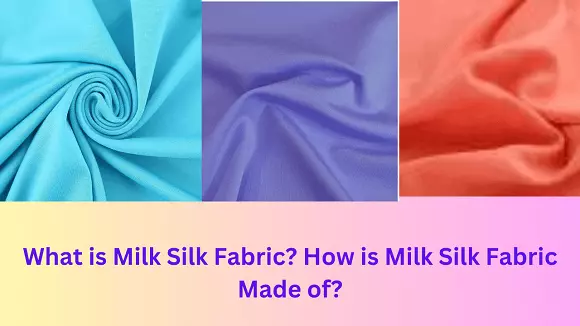Milk silk fabric, a knit Fabric, is also known as Milk fiber, or casein fiber. It is stretchy having 12% spandex blended on it. This property makes this fabric elastic. Since milk silk fabric is smooth and breathable, it is typically thought to be comfortable for regular play. It is also renowned for being hypoallergenic and kind to skin that is sensitive. The thickness, weight, and weaving of the fabric, as well as the style and fit of the garment, will all affect how comfortable it is, just as with any other fabric. Here I present details about What is Milk Silk Fabric? What is Milk Silk Fabric Made of?
According to textile engineer Susan Manganiello, the journey of milk silk begins with the extraction of proteins from milk. Casein, a major milk protein, is used in the production of this fabric.
What is Milk Silk Fabric?
A textile manufactured from a protein fiber obtained from milk is known as silk milk fabric, often referred to as milk silk or milk fiber fabric. Casein, a naturally occurring protein present in milk, is the main source of this special fiber. Casein is extracted through a careful and sustainable process to create a luxurious and eco-friendly fabric. So to define Milk Silk, we can say the Fabric Blend of casein protein from milk and acrylonitrile or pure casein protein.

How is Milk Silk Fabric Made of?
Milk silk fabric, also known as milk fiber or casein fiber, is a fascinating textile that combines the marvels of nature and technology. Derived from the proteins found in milk, this fabric is both sustainable and luxurious. In this article, we will delve into the intriguing process of how this fabric is made.
1. Milk Protein Extraction
The journey of milk silk begins with the extraction of proteins from milk. Primarily, casein, a major milk protein, is used in the production of this fabric. Fresh milk is first skimmed to remove fats and other impurities. The skimmed milk is then subjected to a process called “wet spinning.” During wet spinning, the casein proteins are separated and dissolved in an alkaline solution.
2. Fiber Formation
Once the casein proteins are dissolved, they are transformed into fibers. This process is akin to the traditional spinning of natural silk. The protein solution is forced through small spinnerets to create long, thin strands. These strands are then coagulated in a bath of acid, causing the proteins to solidify into fibers.
3. Stretching and Spinning
The newly formed casein fibers are stretched and spun into threads, which can be further processed into different types of milk silk fabrics. The level of stretching and spinning determines the thickness and texture of the fabric. The result is a lightweight and soft material with a natural sheen, akin to traditional silk.
4. Dyeing and Finishing
After the threads are spun, they undergo the typical dyeing and finishing processes found in the textile industry. This is where the fabric gets its colors, patterns, and textures. Dyes can be applied to create a wide range of designs, from solid colors to intricate prints.
Sustainable Characteristics of Milk Silk Fabric
Milk silk fabric is celebrated for its sustainable qualities. It is biodegradable and environmentally friendly since it is derived from a renewable resource—milk. Additionally, the manufacturing process involves less water usage and chemical treatment compared to conventional textiles, reducing its environmental impact.
Luxurious Feel of Milk Silk Fabric
What sets milk silk apart is its luxurious feel. The fabric is known for being incredibly soft and comfortable against the skin. It drapes elegantly and has a silky smooth texture, making it a popular choice for high-end clothing, lingerie, and other luxurious textiles.
Benefits of Milk Silk Fabric
- Hypoallergenic: It is hypoallergenic, making it a great choice for those with sensitive skin.
- Moisture-wicking: It has the ability to wick moisture away from the body, keeping the wearer comfortable.
- Breathability: Milk silk is breathable, ensuring comfort in various weather conditions.
- UV Resistance: It offers natural UV resistance, providing protection against harmful sun rays.
Milk Silk Fabric vs Spandex; Which is Better?
The choice between milk silk fabric and spandex ultimately depends on your specific needs and preferences. If you value natural, eco-friendly materials and prioritize softness and breathability, milk silk fabric may be the better choice for you, particularly in casual and sleepwear. On the other hand, if you require high stretch, durability, and moisture-wicking properties, spandex is the superior option for activewear and sportswear.
Conclusion
Milk silk fabric is a unique and sustainable textile created from milk proteins. It combines the opulence of traditional silk with the eco-friendliness of a natural resource. The result is a fabric that is not only luxurious to wear but also gentle on the environment. As consumers increasingly seek sustainable and high-quality materials, it is poised to become a popular choice in the world of fashion and textiles.
- You may love to read: What is Milk Cotton Yarn? And Its Properties
- What is Pima Cotton Fabric? Its Properties and Uses
- What is Knitting | Types of (Knitted) Knit Fabrics
- What is Scuba Knit Fabric: Properties and Uses
- What is Leather Fabric: Types, Properties, and Uses
- What are Lining, Padding, Sherpa, and Shell Fabric?
- What is Sherpa Fabric: Characteristics, Types and Uses
